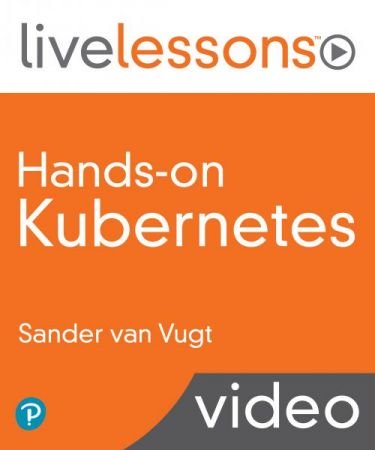 MP4 | Video: AVC 1280 x 720 | Audio: AAC 48 Khz 2ch | Duration: 04:16:10 | 7.73 GB
MP4 | Video: AVC 1280 x 720 | Audio: AAC 48 Khz 2ch | Duration: 04:16:10 | 7.73 GB
Genre: eLearning | Language: English
3+ Hours of Video Instruction
Overview
Hands-on Kubernetes LiveLessons is focused on teaching you real-world skills for configuration and deployment so you can get started with your Kubernetes projects today. This course focuses on you actually doing the work. This course provides more than 4 hours of hands-on tutorials in the form of lightboard explanations and demonstrations so you can immediately get started with Kubernetes. Up-front access to all configuration files is provided.
The course is full of demonstrations, lightboard explanations, and real-world projects. Presented by Sander van Vugt, best-selling author and video presenter, this video course introduces containers and Kubernetes efficiently and quickly. You will move through the process of creation, management, and application storage in a little more than 4 hours. By the end of the course, you will have all the tools necessary to deploy real applications with Kubernetes.
About the Instructor
Sander van Vugt has been teaching Linux classes since 1995 and has written more than 60 books about different Linux-related topics, including the best-selling RHCSA-RHCE 7 Cert Guide. Sander is also the author of more than 25 video courses, including Kubernetes Fundamentalsand Certified Kubernetes Application Developer (CKAD). He teaches courses for customers around the world, and is also a regular speaker at major conferences related to open-source software. Sander is the founder of the Living Open Source Foundation, a nonprofit organization with a focus on teaching open source to talent in Africa.
Skill Level
Beginner/Intermediate
Learn How To
Containerize applications in Kubernetes by following just a few examples
Understand Kubernetes in just a few hours
Dip your toes into Kubernetes before focusing on the CKAD or CKA certification
Who Should Take This Course
System administrators who want to understand the workings of a Kubernetes cluster
Developers who want to run their applications in Kubernetes
Anyone interested in learning all you need to know about Kubernetes in just a few hours
Course Requirements A virtual machine running a recent version of Fedora Workstation
Lesson descriptions
Lesson 1, “Understanding the Kubernetes Revolution,” speaks to the evolution of Kubernetes and how it has become so important. It discusses server-based IT and how that has been made obsolete by the container revolution, and why Kubernetes makes a lot of sense when you are converting to a complete container landscape.
Lesson 2, “Before We Get Started: Let’s Talk Containers!,” provides a minimal understanding of working with containers. You’ll learn how to work with containers, registries, and images and by the time this lesson is over, you’ll have your first container up and running.
Lesson 3, “Setting up a Kubernetes Environment,” explores Kubernetes usage options, including different ways to get started with Kubernetes, after which you can pick the method that works best for you.
Lesson 4, “Running Your First Application,” gets started with the Kubernetes Dashboard, the kubectl command, and how to use them to build your first Kubernetes application!
Lesson 5, “Behind the Scenes: Understanding the API,” further explores what is behind the application and discusses the API, including how to explore what it is offering.
Lesson 6, “Using YAML to Create Kubernetes Objects,” gets into YAML files for replication and explains pods as well as deployments from a YAML file.
Lesson 7, “Understanding Essential Kubernetes Object Components,” covers pod scalability and security, as well as how labels, selectors, and annotations are used within the pods.
Lesson 8, “Making Applications Accessible,” shows how to expose pods using services and Ingress, after which external users should be able to access them.
Lesson 9, “Managing Kubernetes Storage,” starts by showing how to change storage in Kubernetes pods from being ephemeral. This lesson also discusses the different ways to connect an application to internal as well as external storage.
Lesson 10, “Checking it Out in Google Cloud,” quickly goes over how to manage Kubernetes in Google Cloud.
Password/解压密码-0daydown
Download rapidgator
https://rg.to/file/f37aad33b2e4db976175efae6dbb0105/Hands-on_Kubernetes.part01.rar.html
https://rg.to/file/097559e51e465720363cd97cca98ad43/Hands-on_Kubernetes.part02.rar.html
https://rg.to/file/855dee57f78d14af01715a7e934d126f/Hands-on_Kubernetes.part03.rar.html
https://rg.to/file/6f534046be94769ac385810132b3129e/Hands-on_Kubernetes.part04.rar.html
https://rg.to/file/063733f8c47f677b4338613c7d448d95/Hands-on_Kubernetes.part05.rar.html
https://rg.to/file/b81cd492726050fb894adbf648462d25/Hands-on_Kubernetes.part06.rar.html
https://rg.to/file/cd037b4c254130e7c1cb8520b0543f32/Hands-on_Kubernetes.part07.rar.html
https://rg.to/file/234cf5561863b5f4173d650fd7190c0c/Hands-on_Kubernetes.part08.rar.html
https://rg.to/file/86210aebddc49371afdecc1a7af0a798/Hands-on_Kubernetes.part09.rar.html
https://rg.to/file/476054fc4a1d4906da3185a888dc5276/Hands-on_Kubernetes.part10.rar.html
https://rg.to/file/f7a58ab3032728bde9a9d952caa75866/Hands-on_Kubernetes.part11.rar.html
Download nitroflare
https://nitroflare.com/view/8FC61B76166197D/Hands-on_Kubernetes.part01.rar
https://nitroflare.com/view/C3B7EA68D9BBF35/Hands-on_Kubernetes.part02.rar
https://nitroflare.com/view/CF24D9A44B787B6/Hands-on_Kubernetes.part03.rar
https://nitroflare.com/view/29E2CDBAC511EE2/Hands-on_Kubernetes.part04.rar
https://nitroflare.com/view/29340B70AC4C15B/Hands-on_Kubernetes.part05.rar
https://nitroflare.com/view/0B533FD456E3785/Hands-on_Kubernetes.part06.rar
https://nitroflare.com/view/D0554C221F37846/Hands-on_Kubernetes.part07.rar
https://nitroflare.com/view/009AD6C5A7A22B8/Hands-on_Kubernetes.part08.rar
https://nitroflare.com/view/692663C7C301118/Hands-on_Kubernetes.part09.rar
https://nitroflare.com/view/3E370D00001D4A1/Hands-on_Kubernetes.part10.rar
https://nitroflare.com/view/2C2BF6F08B2EE0B/Hands-on_Kubernetes.part11.rar
Download 百度云
你是VIP 1个月(1 month)赞助会员,